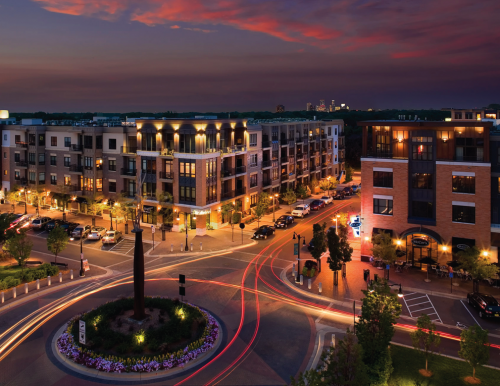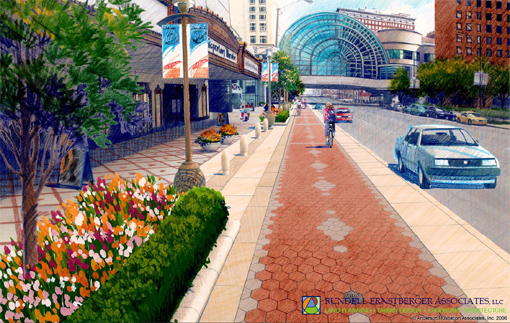Current movements such as Smart Growth and New Urbanism are prevailing, causing urban planners to rethink how we design communities with a focus on the bicycle and pedestrian. These designs reevaluate the transit system, land use patterns and urban design characteristics of an area in order to increase physical activity, specifically when it comes to commuting. Roadways are increasing their density of intersections and shortening grid blocks. This will allow for shorter commutes and more route options. An increase in land use mix means more variation in building type within an area and a combination of residential, commercial and institutional uses. Urban design characteristics include features of the built environment that change one’s perception of their surroundings. The detail and scale at which one notices aspects of the surroundings is inversely proportional to the speed of the traveler. Therefore, a cyclist will notice a lot more about the built environment than will a motorist. Hence, in order to create communities that encourage travel by bicycle, finer detail, smaller buildings, and additional vegetation is proven to help.
Certain features of roadways, such as speed bumps, traffic circles, crosswalks and median barriers, can be incorporated in order to slow traffic to a safe level. In Portland, Oregon, incorporation of four speed bumps caused a 36% reduction in collisions and eight traffic circles observed a 30% reduction in collisions in their immediate locations (City of Portland, Office of Transportation). Features of the built environment for cyclists and pedestrians are also important in creating both a perceived and objectively safe community. A survey by the Bureau of Transportation Statistics showed that nearly half of Americans own or have access to a bicycle. However, without the presence of bike lanes and paths, most report they will not ride their bike.

Main Street, Annapolis Maryland- thinkorthwim.com
“If you build it they will come.” Government spending on transportation is an adequate representation of where priorities are and what direction we see the community going in. The national average spent on pedestrian projects is 55 cents per person whereas highway projects spend $72 per person. Currently only .2% of funding goes to bicycle infrastructure. With a redistribution of this funding and a greater portion towards non-motor vehicles, we will see a paralleled response in mode of transportation. Even an inexpensive $450,000 project to institute additional sidewalks and traffic signals will increase walking. A more expensive project can be justified by eventual returns through health benefits. Part of the prevalence of automobiles is due to the availability of infrastructure. A reduction in subsidized parking and highways would not only free up money for alternative distribution, but would reduce the number of cars on the road. (Boarnet et al 2008).
Another key aspect to New Urbanism is the creation of a sense of community through town centers, pedestrian and bicycle-only streets, parks and green space. These public venues allow for greater interaction between community members and their environment as well as with each other. This feeling of safety and familiarity encourages more people to spend time outdoors within the community and use walking or biking as a mode of transportation. Bicycling in this type of community is much more enjoyable and amounts to more possibilities in the social, environmentally, and for one’s personal health. Due to respective issues in these fields—social isolation, increasing carbon emissions and high rates of obesity—these design techniques for the built environment are becoming more popular and desirable. Incorporated within this image of New Urbanism and the utopian style community is a bicycle—symbolic of both the friendliness and openness of the streets. In this way, the community builds up the use of the bicycle and the bicycle reciprocates in building a sense of community.

Downtown Indianapolis- Streetsblog.com
Back to The Bicycle homepage
